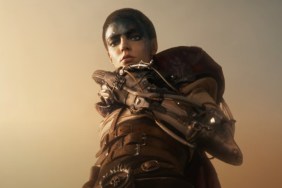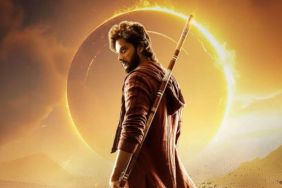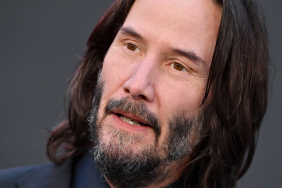
Director Jacob Gentry talks his sci-Fi mindbender Synchronicity in an exclusive interview
Best known for 2007’s The Signal as well as the My Super Psycho Sweet 16 trilogy, filmmaker Jacob Gentry has a reputation for being able to get a lot of visual juice for very little money in his movies, and his latest is no exception. The new sci-fi mindbender Synchronicity has been garnering outstanding notices since its festival debut last year, and it’s deserving in the very palpable world it creates and twisty cul-de-sacs it goes down to tell its story.
In the film, physicist Jim Beale (Chad McKnight) concocts a machine that can fold space-time, and corporate d-bag named Klaus Meisner (the great Michael Ironside) wants to get his hands on the patent by any means necessary. One manipulative femme fatale and an ill-advised trip through time later and we’re on a harried journey to unlock the keys to time travel.
Gentry talked to us in an exclusive interview about making a low-budget movie look like a million bucks, his directorial influences and trading war stories with Michael Ironside.
ComingSoon.net: The development of a time machine is integral to your story. How important was it for you to find the right balance of exposition and just letting the audience accept, “Okay, it’s a time travel movie”?
Jacob Gentry: Yeah, it’s kind of back and forth. I mean, initially, the time travel didn’t actually occur until halfway through the movie. And then, I started backing that up because I was like, everyone knows this is a time travel movie if they’ve seen the trailer. You know, this movie kind of is promising that, so I kinda had to back that up, because I wanted to do a palindrome, initially, and just fold the movie on top of itself and it could like, layer back on top of itself like the city in “Inception,” or something, you know? But I think that it was just a matter of, because that was the MacGuffin of the movie, the time machine, the machine itself, the power to do that, the actual physical ability to travel through a wormhole, that’s what the thing—I mean, the machine is incidental. His ability to open a wormhole in the space/time continuum is something that’s priceless. And the character Klaus, played by Michael Ironside, knows that this is something that if he could figure out how to monetize this, he could be the richest man in the world, you know what I mean? But then also, in addition to time travel, the man who can see 10 seconds in the future could also rule the world. Unlike “Looper,” which I think has some other preoccupations in terms of what it’s really about, this one is driven by that. And I think that ultimately, I didn’t want to just sit around and talk about time travel the whole time, but I wanted there to be enough of an understanding of what that is, so that you can have fun playing a game with the movie.
CS: Right, yeah. “Primer” is an example of a movie where you just get jargon diarrhea and you get lost in it, whereas this was much more straightforward. Even though it’s at the forefront, you just kind of dole out what we need.
Gentry: Well, I mean, a lot of that, actually, to be honest with you, man, is meant to be—it’s like if you watch an Aaron Sorkin, if you watch “The West Wing” or something or “Charlie Wilson’s War” or “The Social Network” or what have you, a lot of what they’re talking about, what’s more important is what’s going on between the two characters. That dialogue of that techno speak, although accurate, kind of is just a way for the audience to feel that they really understand these things, and that they’re submerged in a world, you know? I don’t know how those politicians speak to each other, or I don’t know like in “Steve Jobs,” how well this computer technology works. And it also just kind of gives a verisimilitude to the world. And so, it’s like you were just dropped in the middle of scientists talking about science stuff, and whether you understand what they’re talking about or not, you hopefully can understand the relationships between the characters and what they’re going through and the conflicts.

CS: And not only does the dialogue have a lot of authenticity, but the locations itself, and the look and feel of the movie, it definitely evokes that sort of “Blade Runner,” chiaroscuro future noir thing. How much of that was computers versus just stylized lighting and found locations in Atlanta?
Gentry: Actually, very little. I mean, there was a lot of set extensions, visual effects extensions and what have you. But a surprising amount of the movie was—because there was an architect in Atlanta named John Portman in the ’70s, he created these buildings in downtown Atlanta, and they were futuristic at the time that he created them. His vision of what buildings of the future would look like. I wanted this movie to be as if it was made in 1982, and imagining what the future of 2016 would look like, you know what I mean?
CS: Yeah, retro futurism.
Gentry: Utilizing those locations… I remember being really inspired by the movie “Code 46,” because it was the first science fiction movie I saw where I realized that they were using real places in the world, but it felt like a completely alien, futuristic universe that Michael Winterbottom created in that.
CS: Yeah, I thought about that, too. You had the same methodology that he did, where he just went and found locations that looked futuristic.
Gentry: Yeah, I mean, and as far as budgetary, I wouldn’t have been able to recreate that. Also if it’s supposed to feel like the movie’s made in 1982, I feel like the bulk of it is practical, you know?
CS: Yeah, exactly.
Gentry: We even did a lot of in-camera effects, too, especially whenever there’s two Jim Beales in the scene. I wanted to do a bunch of old school, old fashioned tricks, like in-camera trickery, where he’s running behind the camera. There are like, fake walls and fake rooms, and he’s running behind the camera and ducking under things and changing clothes, (Laughs) all within the same shot. It was cool because it was the same actors AJ, Scotty and Chad, that we did that in our movie, “The Signal.” We had started that, so we kind of did a junior version of that, and then we really got excited about kicking that up a notch in this one. I was also inspired by the Francis Ford Coppola “Dracula.” Did you ever watch the documentary of the making of that?
CS: Oh yeah, Roman Coppola did a lot of that practically. They used a lot of those old school techniques and matte paintings and things like that.
Gentry: Yeah, they wanted it to look like George Melies or with the Lumiere brothers had made the movie. So that’ll be the optical effects and it’s just a fun challenge for a filmmaker, to make a movie like that.
CS: A lot of indie features that I see suffer from a symptom I call “VOD look,” where even if it’s shot competently, there’s always something off about the color timing or even the sound. What were some of the keys to getting your film to look like a movie, as opposed to one of these throwaway indies?
Gentry: I mean, I think it was working with my cinematographer and my production designer. Me and Eric Maddison, the cinematographer, we watched countless amounts of movies and really studied. I’d been working on such small budgets and working in video for so long that my whole 20’s was basically just trying to figure out ways to make videos not look like videos. Certain techniques we developed, and it’s also certain tricks that we learned. I think it’s also just we were very dogmatic about the shooting style, and the shots are very specific. I know a lot of people say that it looks like “Blade Runner,” but that’s only because there’s light coming through the windows and the cyberpunk, future technology. By all means that was an influence, but that movie used longer lenses and there was a cold distance between you and the characters, whereas this has a lot more of a John McTiernan, Michael Curtiz-style of camerawork, where we’re pushing in on these people and really getting up close, because that makes it more relatable. And so, we were just really—I think it was an attention to every shot telling a story, you know? I think the frame is super important and I think that how the camera moves and the techniques you use, I think that that’s a huge part of the subconscious effect on the audience, yeah.

CS: Now your most prominent cast member is without question the great Michael Ironside. I was wondering, do you have a particular favorite film of his?
Gentry: Well, I mean, “Total Recall” is not only one of my favorite films of his, but it might be top 10 of all time.
CS: “See you at the party, Richter.”
Gentry: Yeah, (Arnold Schwarzenegger impersonation) “See you at the party, Richter.” It’s definitely the movie I’ve seen the most times, probably, because I wore out my VHS.
CS: I think I did, too.
Gentry: Yeah, I mean, Verhoeven’s really important. I mean, all of Verhoeven’s movies are very important to me. Funny enough, what was interesting is that working with Michael Ironside, I was so excited to get to hear stories about working with Paul Verhoeven. And I was like, “What was it like working on ‘Starship Troopers?’ What was it like?” Or even Tony Scott and David Cronenberg, and he would always wait to try to tell me an anecdote or an amazing story about what happened on those movies, right before we were about to roll camera, or even in fact when we already started rolling. Like, I had this sort of “Sophie’s Choice” between do I hear a story that I’ve always wanted to hear and I’m in the privileged position of being able to hear it from the man who lived it, or do I make this movie that we’re here and make? I was running out of time before the sun comes up on this city. We’re going to lose the location in an hour and I’ve got to do this, but I really want to hear this story.
CS: Have you gotten any meetings at studios as a result of this film? Like I said, it feels like a big movie and it feels like you should be making big movies.
Gentry: Yeah, it’s definitely cool to have some conversations, and I’ve unfortunately always been sort of—my reputation is the guy who could make stuff look bigger than it actually is. And that’s good and bad, which is it’s kind of a compliment, but it’s also like, no one ever wants to give you more money. So I’m just like, “Just give me a little bit more money and I’ll make it look even bigger.” You know what I mean? So if this looked big, imagine what I could with more. We’ll see. I mean, there’s a bunch of stuff in the works, so we’ll see what happens.
Synchronicity opens in theaters and on iTunes January 22.
Synchronicity
-
Synchronicity

-
Synchronicity

-
Synchronicity

-
Synchronicity

-
Synchronicity

-
Synchronicity

-
Synchronicity

-
Synchronicity

-
Synchronicity

-
Synchronicity

-
Synchronicity










